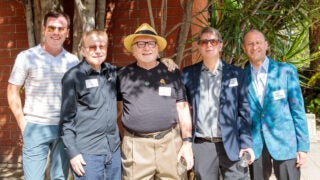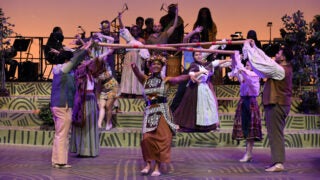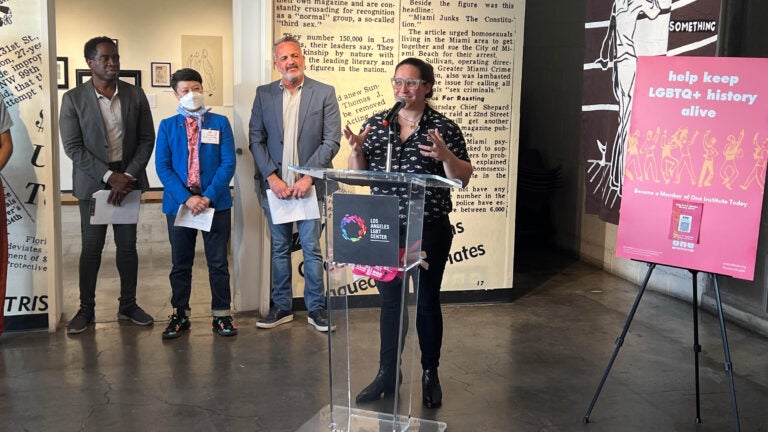
Alexis Bard Johnson, curator of ONE Archives at the USC Libraries, addresses the exhibition’s opening reception. (USC Photo/Greg Hernandez)
‘ONE Magazine at Seventy’ exhibition shines light on historic LGBTQ+ publication
“Themes that came up in the magazine are still relevant and with us today,” says the exhibit’s curator, USC Libraries’ Alexis Bard Johnson.
Alexis Bard Johnson, curator of ONE Archives at the USC Libraries, didn’t want to let LGBTQ+ History Month pass without a major exhibition celebrating the 70th anniversary of ONE magazine. Hailed as the first pro-gay publication to be circulated across the United States, the magazine was the focal point of a landmark U.S. Supreme Court case in 1958.
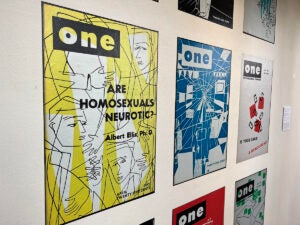
Because ONE Archives — the largest repository of LGBTQ+ materials in the world — has been closed to the public for more than a year due to extensive renovations, Johnson led a small team in creating the ONE Magazine at Seventy exhibition at the Advocate & Gochis Galleries at the Los Angeles LBGT Center. The exhibition can be seen through Nov. 5.
“It’s really heartening to have some of our work on view,” Johnson said to a crowd of more than 300 assembled for the exhibition’s grand opening party on Oct. 1. “As creators, we’re always wondering if what we do is going to matter. Having so many people in the space engaging with the works is really amazing.”
Johnson made her remarks while standing in front of a wall covered with a re-creation of a 1954 centerfold of ONE magazine: a collage of derogatory newspaper headlines where gay people are described as “perverts” and “deviants.”
“We really want to represent how some of the themes that came up in the magazine are still relevant and with us today,” the curator said, referring to current legislative attacks on the rights of the LGBTQ+ community in several states. “You could probably make the same collage today using current headlines.”
‘ONE MAGAZINE AT SEVENTY’
- WHERE: Advocate & Gochis Galleries at the Los Angeles LGBT Center, 1125 N. McCadden Place, Los Angeles.
- WHEN: Noon to 5 p.m. Friday-Sunday through Nov. 5.
The exhibition features several enlarged issues of ONE magazine with such cover stories as “Are Homosexuals Neurotic?,” “Is Your Child a Homosexual?,” “Something About Sailors” and “I Am Glad I Am Homosexual.” Also on display are print blocks used in the production of the magazine; posters advocating or supportive of the interests, civil rights and welfare of gay people; and letters from readers that reflect a need to connect with community but a fear of being found out.
The fight to distribute ONE magazine
Published by Los Angeles-based ONE Inc., the inaugural issue of ONE magazine came out in January 1953; issues continued to be published until December 1967. During those years, the magazine tackled themes such as the protection of free speech, the fight against anti-gay violence by police, the importance of building community, and material on finding ways to cultivate joy at a time when it was all but impossible to be openly gay.
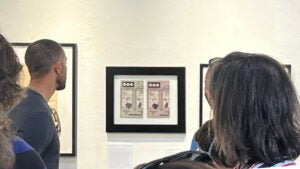
In addition to highlighting how the magazine championed free speech, the documents, audio stories and ephemera that are part of the exhibition also show how ONE magazine served as a linchpin in creating community among those who wrote and published it and those who read it.
In one framed letter that is on display in the exhibit, a South Carolina man wrote: “I recently purchased a copy of ONE on a newsstand and found it informative and enlightening. Should I choose to subscribe, would I be violating any federal law or statute?”
The man had a good reason for his query. In 1954, L.A. Postmaster Otto Olesen declared the October 1954 issue of ONE magazine to be “obscene, lewd, lascivious and filthy” and refused to allow it to be sent through the mail.
The magazine — represented by an attorney who had authored that issue’s cover story — brought a lawsuit to the U.S. District Court seeking an injunction against the postmaster. A federal judge ruled against the magazine in 1956 and the Ninth Circuit Court of Appeals upheld the decision the next year.
Victory came when the case arrived before the U.S. Supreme Court in 1958. The high court, without hearing oral arguments, reversed the appellate court ruling without comment. It was a landmark decision for not only the magazine, but the entire community: the first ruling in U.S. history in favor of LGBTQ+ freedom of speech and expression.
Appreciating the pioneers
The ONE Magazine at Seventy exhibition is being presented as part of Circa: Queer Histories Festival organized by ONE Institute, the oldest active LGBTQ+ organization in the U.S. The opening reception served as the kickoff of the festival.
Some in the crowd expressed their appreciation for those who created content for the magazine, many of whom used pseudonyms.
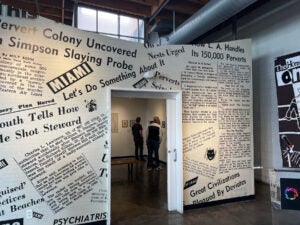
“They are the bravest people, and we should honor them by remembering them,” said Dante Alencastre, an LGBTQ+ documentary filmmaker. “I wouldn’t be here without the love they poured into their work, the love they put into their activism. We need their examples of resiliency more than ever now.”
Another attendee, L.A. resident Morgan Lieberman, said going through the exhibition was “incredibly upsetting” because the battle for LGBTQ+ equality continues — as does backlash against the community.
“A lot of this rhetoric still exists,” she said. “It is an upsetting thing to see, but it’s very humbling at the same time. I feel very privileged that I was born in the 1990s and was able to come out without any repercussions.”
ONE Archives is at 909 W. Adams Blvd. in the University Park neighborhood of L.A. The space is expected to reopen in early 2024 once renovation work is complete.


